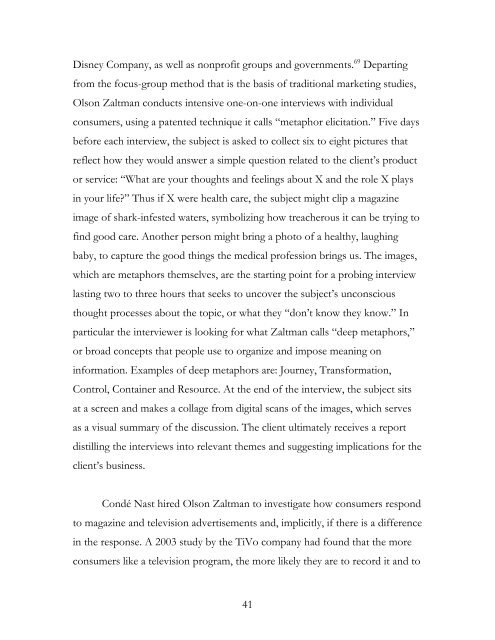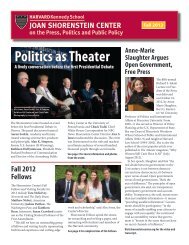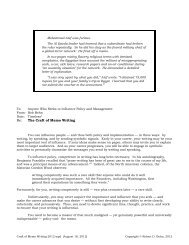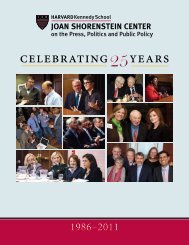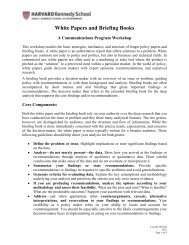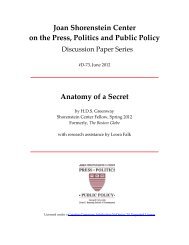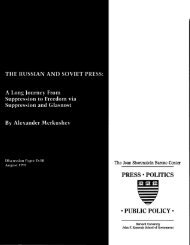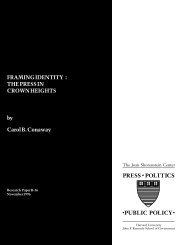Why Paper Is Eternal - Joan Shorenstein Center on the Press ...
Why Paper Is Eternal - Joan Shorenstein Center on the Press ...
Why Paper Is Eternal - Joan Shorenstein Center on the Press ...
You also want an ePaper? Increase the reach of your titles
YUMPU automatically turns print PDFs into web optimized ePapers that Google loves.
Disney Company, as well as n<strong>on</strong>profit groups and governments. 69 Departing<br />
from <strong>the</strong> focus-group method that is <strong>the</strong> basis of traditi<strong>on</strong>al marketing studies,<br />
Ols<strong>on</strong> Zaltman c<strong>on</strong>ducts intensive <strong>on</strong>e-<strong>on</strong>-<strong>on</strong>e interviews with individual<br />
c<strong>on</strong>sumers, using a patented technique it calls “metaphor elicitati<strong>on</strong>.” Five days<br />
before each interview, <strong>the</strong> subject is asked to collect six to eight pictures that<br />
reflect how <strong>the</strong>y would answer a simple questi<strong>on</strong> related to <strong>the</strong> client’s product<br />
or service: “What are your thoughts and feelings about X and <strong>the</strong> role X plays<br />
in your life?” Thus if X were health care, <strong>the</strong> subject might clip a magazine<br />
image of shark-infested waters, symbolizing how treacherous it can be trying to<br />
find good care. Ano<strong>the</strong>r pers<strong>on</strong> might bring a photo of a healthy, laughing<br />
baby, to capture <strong>the</strong> good things <strong>the</strong> medical professi<strong>on</strong> brings us. The images,<br />
which are metaphors <strong>the</strong>mselves, are <strong>the</strong> starting point for a probing interview<br />
lasting two to three hours that seeks to uncover <strong>the</strong> subject’s unc<strong>on</strong>scious<br />
thought processes about <strong>the</strong> topic, or what <strong>the</strong>y “d<strong>on</strong>’t know <strong>the</strong>y know.” In<br />
particular <strong>the</strong> interviewer is looking for what Zaltman calls “deep metaphors,”<br />
or broad c<strong>on</strong>cepts that people use to organize and impose meaning <strong>on</strong><br />
informati<strong>on</strong>. Examples of deep metaphors are: Journey, Transformati<strong>on</strong>,<br />
C<strong>on</strong>trol, C<strong>on</strong>tainer and Resource. At <strong>the</strong> end of <strong>the</strong> interview, <strong>the</strong> subject sits<br />
at a screen and makes a collage from digital scans of <strong>the</strong> images, which serves<br />
as a visual summary of <strong>the</strong> discussi<strong>on</strong>. The client ultimately receives a report<br />
distilling <strong>the</strong> interviews into relevant <strong>the</strong>mes and suggesting implicati<strong>on</strong>s for <strong>the</strong><br />
client’s business.<br />
C<strong>on</strong>dé Nast hired Ols<strong>on</strong> Zaltman to investigate how c<strong>on</strong>sumers resp<strong>on</strong>d<br />
to magazine and televisi<strong>on</strong> advertisements and, implicitly, if <strong>the</strong>re is a difference<br />
in <strong>the</strong> resp<strong>on</strong>se. A 2003 study by <strong>the</strong> TiVo company had found that <strong>the</strong> more<br />
c<strong>on</strong>sumers like a televisi<strong>on</strong> program, <strong>the</strong> more likely <strong>the</strong>y are to record it and to<br />
41


